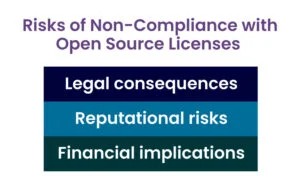Have you ever wondered if using open source software could put your business at risk? While open source offers innovation and cost savings, it also comes with legal and security responsibilities. Open source compliance or adherence ensures companies follow licensing rules, avoid legal trouble, and protect their reputation while benefiting from open source technology.
We will uncover risks as well as best practices of open source adherence in this blog post. Keep reading to understand this concept thoroughly.
Let’s dive in!
Understanding Open Source Compliance
The term “open source compliance” signifies adhering to the rules governing the usage of open source software. An organization’s IT security staff may enforce these internal regulations, or an outside party may impose them.
Policies, privacy, laws and security can all be included in IT compliance, which generally refers to an organization’s adherence to best practices for software development and operation.
While everyone can use open source software for free, it is strongly advised that businesses adhere to compliance guidelines. There might be security issues, software contract violations, or even copyright violations if the rules or guidelines are not followed.
What is Open Source License?
Organizations must abide by the terms and restrictions specified in the applicable open source licenses to utilize open source software in a morally and legally acceptable manner. Although users are granted the freedom to use, alter, and distribute the open source software under these licenses, there are some requirements that must be fulfilled to stay in compliance.
Open source license violations can have detrimental effects on an organization’s future usage of open source software, as well as legal action and harm to the open source community’s reputation. Organizations may continue to profit from open source software while upholding the licenses’ rights and responsibilities by proactively adhering to open source license adherence.
Risks of Non-Compliance
1. Legal consequences
If a business neglects the conditions of these agreements, the software’s copyright owner may take legal action against them. Fines, penalties, and expensive litigation may follow from this.
In certain situations, businesses could have to stop using the non-licensed software, which could cause disruptions to their operations and need expensive replacements or redevelopments.
2. Reputational risks
Strong values of cooperation, openness, and sharing are hallmarks of open source communities. Businesses who are discovered to have violated open source licenses may experience community reaction, which might include bad press, a decline in trust, and harm to their reputation as a brand.
Potential clients, partners, and investors could be reluctant to work with a business that has a track record of breaking open source licenses, which might have long-term repercussions.
3. Financial implications
Along with possible fines and legal fees, businesses may also have to pay for the replacement or redevelopment of software that violates the law. There may be substantial time, money, and labor commitments required for this.
Additionally, if non-compliance prevents businesses from using or contributing to open source projects, they may miss out on the advantages of open source software, including cost savings, innovation, and community support.
4 Best Practices of Open Source Compliance
#1 Putting in place a structured approach for open source compliance
To formally implement an open source compliance program, an organization must develop a set of rules and guidelines that specify how open source software will be used and maintained.
This entails specifying rules for assessing and approving open source components, determining the kinds of open source licenses that are appropriate, and creating procedures for monitoring and recording open source usage. Assuring adherence to open source licensing and addressing any possible problems should also be part of the program.
#2 Putting procedures and technologies in place to monitor open source usage
To ensure adherence to open source licensing, procedures and mechanisms for monitoring open source usage must be put in place. To find open source components and the licenses that go with them, code repositories must be scanned using software composition analysis (SCA) means. These tools may also be used to find any possible vulnerabilities or license problems.
Additionally, businesses should set up procedures for examining and authorizing the usage of open source components, which should include investigating the dependencies and licensing of such components extensively.
#3 Educating staff members on open source compliance and licensing
The many kinds of open source licenses, their conditions and limitations, and the best ways to integrate open source elements into proprietary software should all be covered in this training.
The need to keep thorough records of open source usage and the possible consequences of non-compliance should also be taught to staff members. Employees should get regular updates and training to stay up to speed on any modifications to open source license and compliance standards.
#4 Work together with legal professionals
Companies should work with legal professionals to guarantee complete adherence to open source licensing. These experts assist in risk mitigation, policy development that complies with legal requirements, and the interpretation of complicated license conditions.
Frequent discussions can protect intellectual property and save expensive legal problems. Organizations may utilize open source software with confidence while avoiding legal issues and upholding industry best practices by incorporating legal knowledge into their compliance plan.
Staying Compliant Means Staying Secure!
Open source compliance is about safeguarding your company, reputation, and software integrity, not just obeying regulations. Businesses may take advantage of open source while maintaining compliance by putting best practices into place, educating staff, and consulting with legal professionals. In the current digital environment, a proactive strategy guarantees security, trust, and long-term success.
Take charge of your open source strategy now – use best practices and maintain compliance to safely encourage creativity!
For more digital safety related content, keep visiting YourTechDiet and keep reading our insightful blogs.


